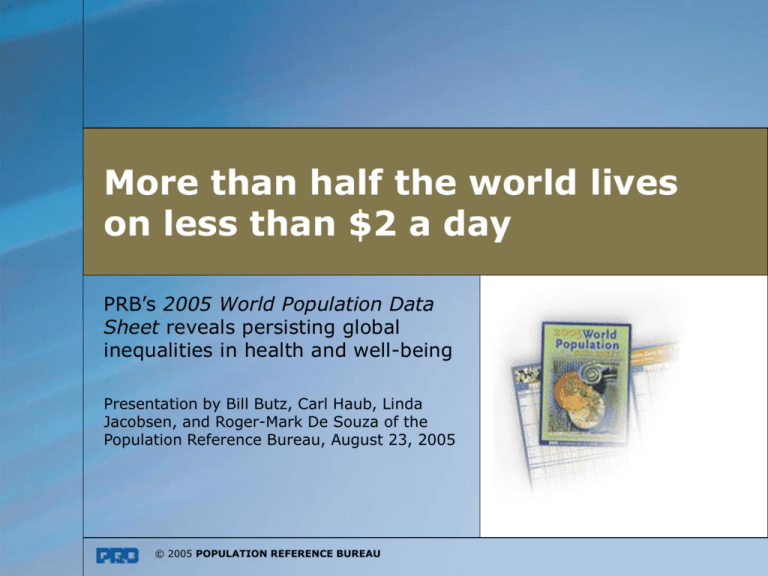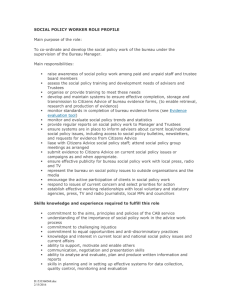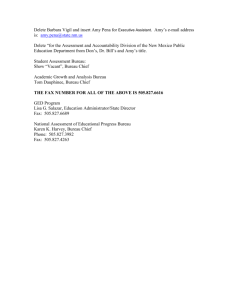PowerPoint - Population Reference Bureau
advertisement

More than half the world lives on less than $2 a day PRB’s 2005 World Population Data Sheet reveals persisting global inequalities in health and well-being Presentation by Bill Butz, Carl Haub, Linda Jacobsen, and Roger-Mark De Souza of the Population Reference Bureau, August 23, 2005 © 2005 POPULATION REFERENCE BUREAU The “Demographic Divide”: The example of Tanzania and Poland Tanzania Poland Population 2005 (millions) 36.5 38.2 Population 2050 71.4 32.4 5.7 1.2 1,500,000 355,000 45 14 3 20 44 82 105,000 2,400 73 <2 Lifetime Births per Woman Annual Number of Births Percent of Population Below Age 15 Percent of Population Age 65+ Life Expectancy at Birth Annual Number of Infant Deaths Percent Living Below US$2 a Day © 2005 POPULATION REFERENCE BUREAU Global population growth: A developing country phenomenon Billions 9 8 7 6 5 4 3 Developing countries 2 1 Developed countries 0 1 9 5 0 1 9 5 5 1 9 6 0 1 9 6 5 1 9 7 0 1 9 7 5 1 9 8 0 1 9 8 5 1 9 9 0 1 9 9 5 2 0 0 0 2 0 0 5 2 0 1 0 2 0 1 5 2 0 2 0 2 0 2 5 2 0 3 0 2 0 3 5 2 0 4 0 2 0 4 5 2 0 5 0 Source: United Nations Populations Division, World Population Prospects, The 2004 Revision, medium variant. © 2005 POPULATION REFERENCE BUREAU Europe is the only world region projected to decline in population by 2050. Millions North America Latin America/ Caribbean Europe Africa 457 326 778 549 668 728 2050 2005 1,941 885 Asia © 2005 POPULATION REFERENCE BUREAU 5,385 3,875 In the developed countries there are fewer and fewer young people, more and more elderly (2005). Millions Age 80+ Males 70-74 Females 60-64 50-54 40-44 30-34 20-24 10-14 0-4 300 200 100 00 100 200 Source: United Nations Populations Division, World Population Prospects, The 2004 Revision. © 2005 POPULATION REFERENCE BUREAU 300 The young population of the developing countries has great growth potential (2005). Millions Age 90+ 80-84 Males Females 70-74 60-64 50-54 40-44 30-34 20-24 10-14 0-4 300 200 100 00 100 200 300 Source: United Nations Populations Division, World Population Prospects, The 2004 Revision. © 2005 POPULATION REFERENCE BUREAU India’s fertility has declined in fits and starts. Births per 1,000 population 40 35 30 25 Birth rate stabilizes following unpopular birth control program during the “emergency” of the 1970s 20 15 Resumption of gradual birth rate decrease 10 5 0 1 9 7 1 1 9 7 3 1 9 7 5 1 9 7 7 1 9 7 9 1 9 8 1 1 9 8 3 1 9 8 5 1 9 8 7 1 9 8 9 1 Source: Registrar General of India, Sample Registration System. © 2005 POPULATION REFERENCE BUREAU 9 9 1 1 9 9 3 1 9 9 5 1 9 9 7 1 9 9 9 2 0 0 1 2 0 0 3 Fertility varies widely across the states of India. Children per woman Kerala 1.8 Tamil Nadu 2 Andhra Pradesh Maharashtra Karnataka 2.2 2.3 2.4 Orissa Gujarat Haryana Madhya Pradesh Rajasthan Bihar Uttar Pradesh Source: Registrar General of India, Sample Registration System, 2002. © 2005 POPULATION REFERENCE BUREAU 2.6 2.8 3.1 3.8 3.9 4.3 4.4 Thailand represents a smooth transition to below-replacement fertility. Children per woman 7 6 5 4 3 Family planning program officially begins 2 1 0 1950- 1955- 1960- 1965- 1970- 1975- 1980- 1985- 1990- 1995- 20001955 1960 1965 1970 1975 1980 1985 1990 1995 2000 2005 Source: United Nations Population Division and Population Reference Bureau. © 2005 POPULATION REFERENCE BUREAU Fertility is higher in the United States than in most other developed countries. Children per woman South Korea 1.19 Italy 1.26 Japan 1.28 Germany 1.3 Spain 1.3 Canada 1.49 United Kingdom 1.72 Netherlands 1.73 Sweden Australia France United States Source: PRB, 2005 World Population Data Sheet. © 2005 POPULATION REFERENCE BUREAU 1.74 1.77 1.9 2.03 Fertility differs considerably among race and ethnic groups in the United States. Children per woman White, nonHispanic 1.86 Asian/Pacific Islander 1.87 Black, nonHispanic Hispanic Mexican Source: National Center for Health Statistics. © 2005 POPULATION REFERENCE BUREAU 2.03 2.79 2.88 People are living longer than ever before in the U.S., but gaps in life expectancy between blacks and whites persist. Years 85 White female 80 Black female 75 70 White male 65 Black male 60 © 2005 POPULATION REFERENCE BUREAU 2 0 0 0 2 0 0 8 2 9 9 6 1 9 9 4 1 9 9 2 1 9 9 0 1 9 9 8 Source: National Center for Health Statistics. 1 9 8 6 1 9 8 4 1 9 8 2 1 1 9 8 0 9 8 8 1 9 7 6 1 7 9 1 1 9 7 0 55 Infant mortality for blacks has remained twice as high as infant mortality for whites since the early 1980s. Infant deaths per 1,000 births 25 20 • Black, non-Hispanic 15 10 • Hispanic 5 • White, non-Hispanic • Asian 0 1 9 8 3 1 9 8 4 1 9 8 5 1 9 9 0 1 9 9 1 1 9 9 5 Source: National Center for Health Statistics. © 2005 POPULATION REFERENCE BUREAU 1 9 9 6 1 9 9 7 1 9 9 8 1 9 9 9 2 0 0 0 2 0 0 1 2 0 0 2 Decreases in the rates of child poverty have not closed the gap between minority and white children. Percent living in poverty 50 Black 45 40 Hispanic 35 30 25 20 15 10 White, non-Hispanic 5 0 1 9 8 0 1 9 8 5 1 9 9 0 1 9 9 3 1 9 9 5 1 9 9 7 1 9 9 8 1 Source: Federal Interagency Forum on Child and Family Statistics. © 2005 POPULATION REFERENCE BUREAU 9 9 9 2 0 0 0 2 0 0 1 2 0 0 2 2 0 0 3 © 2005 POPULATION REFERENCE BUREAU In many parts of the world, rural populations still lack access to safe drinking water. Sub-Saharan Africa 45 82 80 South-Central Asia East Asia Western Asia Latin America/Caribbean Eastern Europe North America Source: Based on UNICEF, End-Decade Databases, January 2005. © 2005 POPULATION REFERENCE BUREAU 94 69 94 73 95 69 96 81 99 100 100 Rural Urban Six of the top 15 energy users are lowincome countries. Total energy use, in millions of metric tons of oil equivalent, 2002 Iran, Islamic Rep. Indonesia Mexico Italy Brazil Korea, Rep. United Kingdom Canada France Germany Japan India Russian Federation China 133 156 157 172 190 203 226 250 265 346 516 538 617 United States Source: World Bank, 2005 World Development Indicators: table 3.7. © 2005 POPULATION REFERENCE BUREAU 1,228 2,290 High-income countries have the highest energy use per capita. Energy use per capita, in thousands of kilograms of oil equivalent, 2002 France New Zealand Netherlands Belgium Sweden Australia 4.5 4.6 4.8 5.5 5.7 Saudi Arabia 5.7 5.8 Norway 5.8 Singapore Finland Trinidad & Tobago 6.1 6.9 United States Canada Kuwait United Arab Emirates Source: World Bank, 2005 World Development Indicators: table 3.7. © 2005 POPULATION REFERENCE BUREAU 7.1 7.9 8 9.5 9.6 © 2005 POPULATION REFERENCE BUREAU





